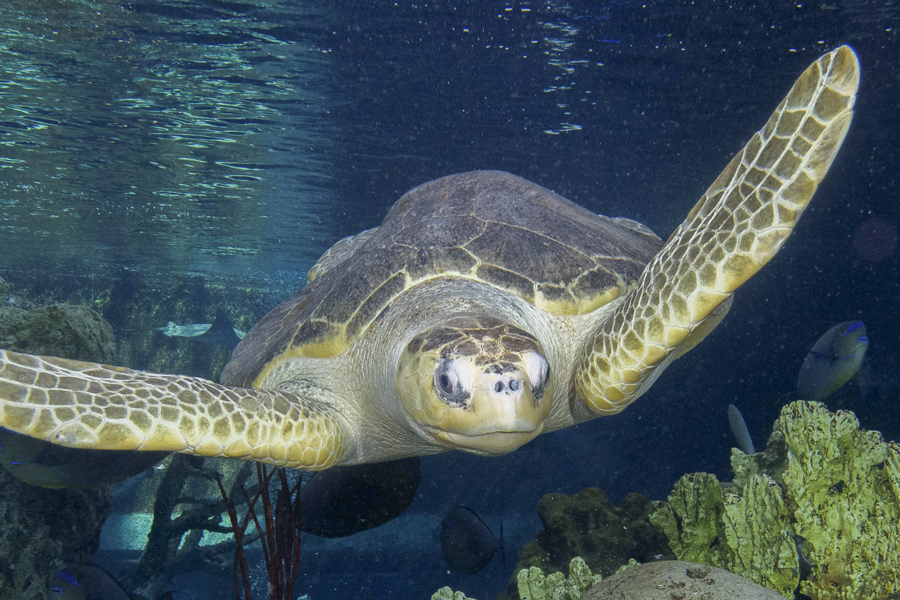Our Animals
Read profiles of the animals highlighted in our new Coral Reefs exhibits.

Credit: Ken Kurtis/Aquarium of the Pacific

Credit: Andrew Reitsma
Corals
Class Anthozoa
Coral reefs are among the most biodiverse ecosystems in the ocean. Because of their diversity of species, coral reefs could be the best sources for new medicines. This underscores the necessity of protecting and conserving coral reefs. They are also important to people as fishing grounds and a source of food, and they protect coastlines from rising seas. While coral reefs cover less than one percent of the ocean floor, more than 25 percent of all marine fish species depend upon them. Coral reefs are the world’s most diverse marine ecosystems, filled with colorful fish and invertebrates that are found nowhere else on Earth. Featured corals you can see at the Aquarium of the Pacific include staghorn, black, and lettuce coral.

Credit: Ken Kurtis/Aquarium of the Pacific
Green sea turtle
Chelonia mydas
Green sea turtles can grow up to 4 feet long, weigh up to 440 pounds, and live as long as 80 years. They live in tropical and subtropical waters around the world. They are herbivores and primarily eat sea grass, but as juveniles may eat sea jellies and other invertebrates or animals without backbones. Single-use plastic bags can end up in the ocean and resemble sea jellies; avoiding their use is one way to help this species.

Credit: Robin Riggs
Red-footed booby
Sula sula
Sula is the name of the Aquarium’s red-footed booby, and her name is also part of this species’ scientific name. Sula is one of two red-footed boobies known to be living at a zoo or aquarium. They get their common name from their red feet and have blue and pink colored beaks. In the wild, this seabird species faces threats from humans overfishing their sources of food and coastal development. They live in colonies and nest in coastal trees and shrubs near coral reefs and lagoons. Also, some studies have indicated their droppings can help the productivity of coral reefs.

Flashlight fish
Family Anomalopidae
Flashlight fish live in the Indo-Pacific and Caribbean Oceans. These fish have organs near their eyes that contain bioluminescent bacteria that emit light. The fish can rotate the light organs to flicker on and off to detect prey in the dark.

Credit: Ken Kurtis/Aquarium of the Pacific
Clownfish
Amphiprion spp.
These fish live in host anemones on coral reefs and in lagoons in tropical waters. They have a special relationship with their host anemone and rarely leave it. The anemone protects the fish, and the fish helps clean and feed the anemone.

Credit: Aquarium of the Pacific/Andrew Reitsma
Parrotfish
Family Scaridae
Parrotfish use their large, sharp beaks to scrape off pieces of coral and eat the algae that lives in the coral’s tissues as well as the coral’s calcium carbonate skeleton. Through this process, parrotfish and other species that eat coral help to control coral growth. They digest coral skeletons into the fine, white sand we find on tropical beaches.

Credit: iStock.com / scubaluna
Pom-pom crab
Lybia leptochelis
These tiny coral crabs can be found carrying living sea anemones in their claws, which give them the nickname cheerleader crabs. The anemones help protect them from predators and even assist them in getting their next meal. The anemones have stinging cells that the pom-pom crab can use to deter predators by “punching” them, so this crab is sometimes also called the boxing crab.

Twinspot lionfish
Dendrochirus biocellatus
With fan-like appendages and stripes in black, white, and red, this lionfish species can use its venomous spines to discourage predators from eating it. It is the only species of lionfish with two appendages on its chin.

Credit: Aquarium of the Pacific
Crown-of-thorns sea star
(Acanthaster planci)
These venomous sea stars eat living coral as part of their natural diets in the wild. On a healthy reef system, the crown-of-thorns sea star plays an important role in the ecosystem by creating opportunities for new coral growth, including of more species of coral. However, when the system is out of balance (when predators of this sea star have been overfished or the reef is stressed by temperature changes), the population of these sea stars can increase and cause significant damage to the reef ecosystem. Experts at the Aquarium feed their crown-of-thorns sea star a variety of foods so that it does not require living coral.

Credit: Aquarium of the Pacific
Sexy shrimp
Thor amboinensis
These tiny shrimp, which can grow to be up to half an inch in length, live symbiotically with coral. They characteristically hold up and sway their tails, and some describe this motion as dance-like. These shrimp were successfully bred by the Aquarium of the Pacific. The Aquarium recently added sexy shrimp to its Jewels exhibit in the Tropical Pacific Gallery.

